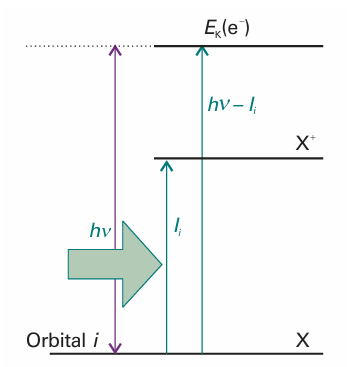
Photoelectron spectroscopy
 المؤلف:
Peter Atkins، Julio de Paula
المؤلف:
Peter Atkins، Julio de Paula
 المصدر:
ATKINS PHYSICAL CHEMISTRY
المصدر:
ATKINS PHYSICAL CHEMISTRY
 الجزء والصفحة:
ص378-379
الجزء والصفحة:
ص378-379
 2025-11-27
2025-11-27
 60
60
Photoelectron spectroscopy
So far we have treated molecular orbitals as purely theoretical constructs, but is there experimental evidence for their existence? Photoelectron spectroscopy (PES) measures the ionization energies of molecules when electrons are ejected from different orbitals by absorption of a photon of the proper energy, and uses the information to infer the energies of molecular orbitals. The technique is also used to study solids, and in Chapter 25 we shall see the important information that it gives about species at or on surfaces. Because energy is conserved when a photon ionizes a sample, the energy of the incident photon hν must be equal to the sum of the ionization energy, I, of the sample and the kinetic energy of the photoelectron, the ejected electron (Fig. 11.34):
hν = 1/2mev2 + I
This equation (which is like the one used for the photoelectric effect, Section 8.2a) can be refined in two ways. First, photoelectrons may originate from one of a number of different orbitals, and each one has a different ionization energy. Hence, a series of different kinetic energies of the photoelectrons will be obtained, each one satisfying
hν = 1/2mev2 + Ii
where Ii is the ionization energy for ejection of an electron from an orbital i. Therefore, by measuring the kinetic energies of the photoelectrons, and knowing ν, these ionization energies can be determined. Photoelectron spectra are interpreted in terms of an approximation called Koopmans’ theorem, which states that the ioniza tion energy Ii is equal to the orbital energy of the ejected electron (formally: Ii =−εi). That is, we can identify the ionization energy with the energy of the orbital from which it is ejected. Similarly, the energy of unfilled (‘virtual orbitals’) is related to the elec tron affinity. The theorem is only an approximation because it ignores the fact that the remaining electrons adjust their distributions when ionization occurs. The ionization energies of molecules are several electronvolts even for valence elec trons, so it is essential to work in at least the ultraviolet region of the spectrum and with wavelengths of less than about 200 nm. Much work has been done with radiation generated by a discharge through helium: the He(I) line (1s12p1 → 1s2) lies at 58.43 nm, corresponding to a photon energy of 21.22 eV. Its use gives rise to the technique of ultraviolet photoelectron spectroscopy (UPS). When core electrons are being studied, photons of even higher energy are needed to expel them: X–rays are used, and the technique is denoted XPS. The kinetic energies of the photoelectrons are measured using an electrostatic deflector that produces different deflections in the paths of the photoelectrons as they pass between charged plates (Fig. 11.35). As the field strength is increased, electrons of different speeds, and therefore kinetic energies, reach the detector. The electron flux can be recorded and plotted against kinetic energy to obtain the photoelectron spectrum.

Fig. 11.34 An incoming photon carries an energy hν; an energy Ii is needed to remove an electron from an orbital i, and the difference appears as the kinetic energy of the electron.

Fig. 11.35 A photoelectron spectrometer consists of a source of ionizing radiation (such as a helium discharge lamp for UPS and an X-ray source for XPS), an electrostatic analyser, and an electron detector. The deflection of the electron path caused by the analyser depends on their speed.


 الاكثر قراءة في مواضيع عامة في الكيمياء الفيزيائية
الاكثر قراءة في مواضيع عامة في الكيمياء الفيزيائية
 اخر الاخبار
اخر الاخبار
اخبار العتبة العباسية المقدسة


